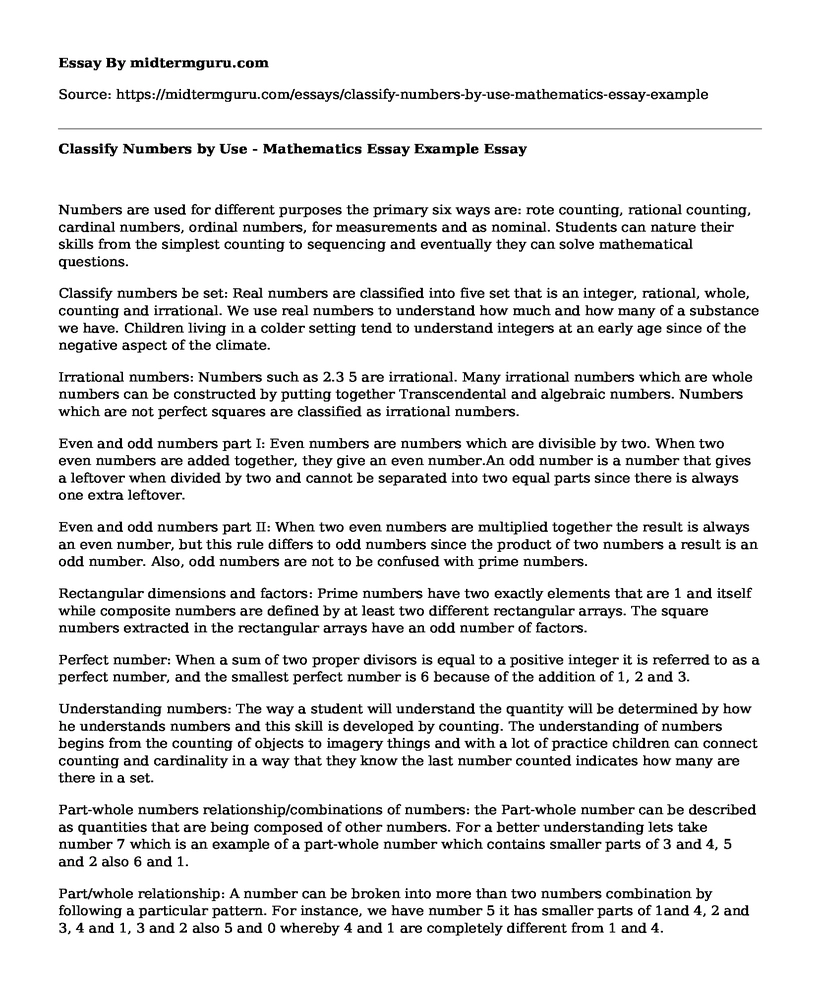Numbers are used for different purposes the primary six ways are: rote counting, rational counting, cardinal numbers, ordinal numbers, for measurements and as nominal. Students can nature their skills from the simplest counting to sequencing and eventually they can solve mathematical questions.
Classify numbers be set: Real numbers are classified into five set that is an integer, rational, whole, counting and irrational. We use real numbers to understand how much and how many of a substance we have. Children living in a colder setting tend to understand integers at an early age since of the negative aspect of the climate.
Irrational numbers: Numbers such as 2.3 5 are irrational. Many irrational numbers which are whole numbers can be constructed by putting together Transcendental and algebraic numbers. Numbers which are not perfect squares are classified as irrational numbers.
Even and odd numbers part I: Even numbers are numbers which are divisible by two. When two even numbers are added together, they give an even number.An odd number is a number that gives a leftover when divided by two and cannot be separated into two equal parts since there is always one extra leftover.
Even and odd numbers part II: When two even numbers are multiplied together the result is always an even number, but this rule differs to odd numbers since the product of two numbers a result is an odd number. Also, odd numbers are not to be confused with prime numbers.
Rectangular dimensions and factors: Prime numbers have two exactly elements that are 1 and itself while composite numbers are defined by at least two different rectangular arrays. The square numbers extracted in the rectangular arrays have an odd number of factors.
Perfect number: When a sum of two proper divisors is equal to a positive integer it is referred to as a perfect number, and the smallest perfect number is 6 because of the addition of 1, 2 and 3.
Understanding numbers: The way a student will understand the quantity will be determined by how he understands numbers and this skill is developed by counting. The understanding of numbers begins from the counting of objects to imagery things and with a lot of practice children can connect counting and cardinality in a way that they know the last number counted indicates how many are there in a set.
Part-whole numbers relationship/combinations of numbers: the Part-whole number can be described as quantities that are being composed of other numbers. For a better understanding lets take number 7 which is an example of a part-whole number which contains smaller parts of 3 and 4, 5 and 2 also 6 and 1.
Part/whole relationship: A number can be broken into more than two numbers combination by following a particular pattern. For instance, we have number 5 it has smaller parts of 1and 4, 2 and 3, 4 and 1, 3 and 2 also 5 and 0 whereby 4 and 1 are completely different from 1 and 4.
Exploring combinations: Under this unit, the student can understand that there are several ways to have a whole number and similarly having different smaller parts combined that can add up to the whole number.
Prime factors: A prime factor can be best redefined as a number which is divisible by one and itself, and they are used to determine different factors of a number.
Negative and positive numbers relationship: to determine if a number is positive or negative there is the use of a number line and the value is determined from the zero position. A positive number doesnt have to have the positive sign, but a negative number has to have the negative sign.
Number line: the number line is used to determine the distance of the number from the zero the left side from zero is negative and the right side from zero is positive.
Our place-value numeration system: this is a way of collecting symbols that are represented in a way that we can able write all numbers. They are a group starting from ones, tens, hundreds, thousands and so on.
Different numeration system: this whereby smaller parts of a number which are subdivided into a bigger pack for instance how biscuits are packed in a box gives a better example in this case.
Places less than one: This is where a whole number is being divided by a larger number than itself. For instance sharing one orange amongst 8 people it means they will get an eighth of a piece each.
Teaching sense: teaching students the ability to solve mathematical problems starts from the very basic area of counting, and one matures to the capacity to solve harder questions.
Cite this page
Classify Numbers by Use - Mathematics Essay Example. (2021, Jun 02). Retrieved from https://midtermguru.com/essays/classify-numbers-by-use-mathematics-essay-example
If you are the original author of this essay and no longer wish to have it published on the midtermguru.com website, please click below to request its removal:
- African and Asian Origin - Essay Sample
- Essay Sample: How Big Data Analysis Can Play a Role in Development of Africa
- Inequalities: Understanding the Language of Math in Everyday Life - Essay Sample
- Fire Dynamics Case Study
- The Earliest Bipedal Hominids: Taung Child & Neanderthals - Essay Sample
- Math Education: Field Experiences for Improvement - Research Paper
- Understanding Cultural Anthropology: Ethical Methods & Code of Ethics - Essay Sample







